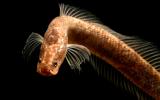The groundwater of the Western Ghats, a mountain range in India, is home to various highly specialized fish species. Last year a new species was found there, Aenigmachanna gollum. At first sight the fish seemed to be representatives of the snakehead family. However, studies published today in "Scientific reports" now show that it belongs to a new fish family.
All good things come in threes
Based on computer tomographic (CT), genetic and morphological studies, Rüber and his colleagues could find some significant differences between Aenigmachanna gollum and representatives of the snakehead family Channidae. "Particularly noticeable are the shortened swim bladder and the absence of the accessory respiratory organ, both defining characteristics of snakeheads", the biologist from Bern explains. "The morphological and genetic differences were so great that we assigned Aenigmachanna gollum to a new family, the Aenigmachannidae!"
A living fossil
The researchers also write in their study that the slender fish, about ten centimeters long, has some evolutionary very primitive characteristics. An explanation for this could be the evolutionary history of the animal: The analysis of the phylogenetic relationships shows that the new family separated from the snakehead fish (Channidae) at least 34 or even 109 million years ago. "It seems plausible that the Aenigmachannidae are an evolutionary lineage that survived the break-up of the supercontinent Gondwana about 100 million years ago and then drifted northwards with the Indian subcontinent - therefore the animals can also be called 'living fossils' as they still show many primitive characteristics", adds Rüber.
Threatened wells
However, the special way of life of the new fish family could become a threat to them: Aenigmachanna gollum lives underground in water-bearing rocks. "These groundwater resources are used for more than six million private wells - increased water extraction would literally deprive the fish of their livelihood," concludes Rüber.




